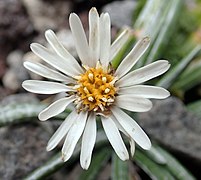Celmisia major
| Celmisia major | |
|---|---|

| |
| Celmisia major var. major | |

| |
| Celmisia major var. brevis | |
| Scientific classification | |
| Kingdom: | Plantae |
| Clade: | Tracheophytes |
| Clade: | Angiosperms |
| Clade: | Eudicots |
| Clade: | Asterids |
| Order: | Asterales |
| Family: | Asteraceae |
| Genus: | Celmisia |
| Species: | C. major
|
| Binomial name | |
| Celmisia major | |

| |
| Native distribution of Celmisia major (North Island of New Zealand) | |
Celmisia major is a species of
Taxonomy
Description
Celmisia major var. brevis can be differentiated from var. major by its smaller size and its more open and weakly developed pseudo-involucre. Celmisia major var. brevis is also range restricted on Mount Taranaki.[1]
var. brevis
Celmisia major var. brevis is a small herb with tufted leaves and simple or branched stems.
A short-lived plant, it is described as one of the few members of the genus Celmisia who do well in cultivation. It grows well from fresh seed and does well in a semi-shaded site with moist and free-draining soil. It does not prefer humidity.[1]
var. major
Celmisia major var. major is a tufted herb. The leaves are 100–400 millimetres (3.9–15.7 in) in length and 5–20 millimetres (0.20–0.79 in) in width. They range in shape from narrow and linear to lanceolate. The leaves are leathery in texture and have a dark green upper surface, with an often fractured skin, leaving the leaves with a silvery green mottled appearance. The underside of the leaves are hairy and silvery white. The flower stem, also known as the scape, ranges from hairy to smooth, the flower head is 20–40 millimetres (0.79–1.57 in) in diameter. The flower head is white and yellow, the plant flowers from the months of August to February, with its peak at October to November. The plant begins to fruit between the months of October and May, but with a peak in December.[4]
The plant is easy to sow from seeds or through dividing the plants. The plant prefers moist soil with sunlight and no weeds.[4]
-
Detail of the flower of var. brevis
-
Detail of the flower of var. major
Distribution
var. brevis
Celmisia major var. brevis is endemic to Mount Taranaki, formerly known as Mount Egmont.[1]
var. major
Celmisia major var. major is found on New Zealand's North Island. It is found in West Auckland, from Muriwai to Cornwallis, as well as the islands of Aiguilles Island, Great Barrier Island, where it may be extinct, and Kaikōura Island.[4]
Habitat
var. brevis
The plant is found in the alpine and subalpine herbfields of Mount Taranaki.[1]
var. major
The plant is strictly found on the coast. It is found on rock headlands, cliff faces, and islets, and occasionally on coastal shrublands. The plant grows on low turf on soils consisting of peat or silt. The plant grows in association with plants in the genera Disphyma, Samolus, and Tetragonia.[4]
Conservation
var. brevis
It is currently ranked as "At Risk – Naturally Uncommon" after a 2009 review, and this designation was renewed in a 2012 review. It was previously designated "Range Restricted" in a 2004 review by the New Zealand Threat Classification System.[1]
The plant is naturally uncommon, as it is only found in the Mount Taranaki National Park. Despite its small and restricted range, it is abundant where it is actually found.[1]
var. major
Celmisia major var. major is currently ranked as "At Risk-Naturally Uncommon" following a 2012 review by the New Zealand Threat Classification System. It was first given this designation in 2009, having previously been assessed at "Gradual Decline" in 2004.[4]
It is threatened by habitat encroachment by other plants, which grow faster and taller than the daisy, as well as threats from coastal erosion. Since the daisy is found in sites with heavy foot traffic, the plants have been trampled by individuals seeking to access popular headland and shore inlet sightseeing sites. Overcollecting also serves as a factor in decline. The plant is scarce on Great Barrier Island, only being found in a single location.[4]
Etymology
The generic epithet is derived from
References
- ^ a b c d e f g h i j k de Lange, P.J. (1 February 2009). "Celmisia major var. brevis". New Zealand Plant Conservation Network. Retrieved 26 April 2022.
- Wikidata Q115528659
- ^ "Celmisia major". Mindat.org. Retrieved 26 April 2022.
- ^ a b c d e f g h de Lange, P.J. (1 February 2009). "Celmisia major var. major". New Zealand Plant Conservation Network. Retrieved 26 April 2022.



